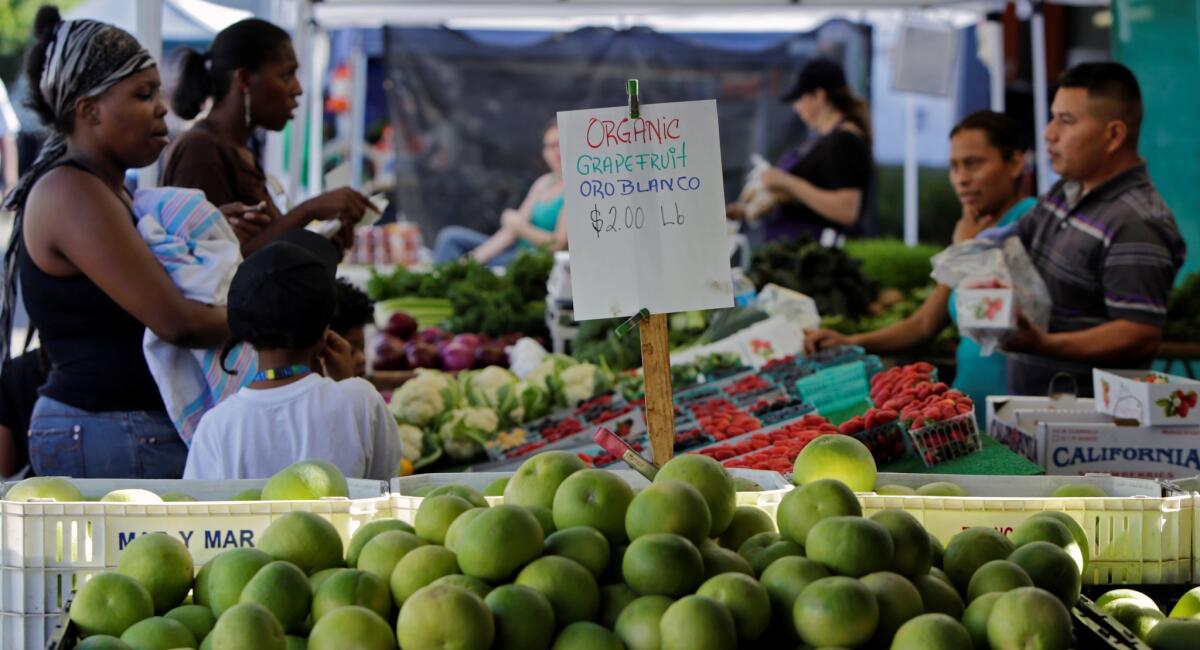Has the farmers market movement peaked?

- Share via
Have farmers markets become too plentiful for their own good? That’s a question farmers and market managers have been asking for several years. And now there’s evidence that suggests it may be so.
A new study by the Department of Agriculture finds that the rate of growth in the number of farmers markets nationally has slowed dramatically in the last five years.
That decline was particularly notable in Los Angeles County, historically on the leading edge of the farmers market movement, where according to USDA statistics, total sales dropped by almost 43% in real dollars between 2007 and 2012.
------------
FOR THE RECORD
March 2, 9:35 a.m.: An earlier version of this article stated that sales at Los Angeles County farmers markets had fallen by almost 43% between 2007 and 2012. The figure represents the decrease in direct-marketing sales by Los Angeles County farmers -- primarily at farmers markets. There are no statistics kept for farmers’ market sales.
------------
The report, “Trends in U.S. Local and Regional Food Systems,” finds that though the number of farmers markets nationally grew at an annual rate of 17% between 2002 and 2007, that rate has slowed to 5.5% per year since.
Though most of the rest of the nation didn’t experience declines on the order of Southern California, where total revenue declined to $2.3 million in 2012 from $4.2 million in 2007 (measured in constant dollars), total revenue at all markets in the United States fell by 1% in real dollars during that period. That’s after having grown by 32% between 2002 and 2017 and 36% between 1997 and 2002.
What’s more, those numbers include not just farmers markets, but all direct-to-consumer sales, including CSA boxes, roadside stands and U-Picks.
This doesn’t come as news to Southern California market managers like Diana Rodgers, who runs the Mar Vista farmers market.
“There’s been concern for several years among some of my colleagues that their markets have been dropping,” she says. “I think we’ve glutted the marketplace.”
Jackie Sauceda-Rivera, who helps oversee eight Los Angeles markets for SEE-LA, agrees. “I think there is definitely a saturation of the market that makes it harder for new markets to thrive as quickly as they did before,” she says.
The problem has been that the number of markets has grown faster than the number of farmers to supply them and the number of shoppers to buy from them. There are more than 200 farmers markets in Southern California today and shoppers can choose among more than 40 markets every Thursday, Saturday and Sunday.
“Every little borough, every little community wants a farmers market now,” Rodgers says. “Not because of what farmers markets are, but because they attract foot traffic.
“Everybody wants to put them in but they don’t want to make sure they’re valid farmers markets. A lot of these are called farmers markets, but they’re not actually farmers markets. They operate in name only.”
This leads to a situation where there are too many markets and not enough farmers and shoppers.
“There’s definitely a cannibalization of farmers and shoppers, especially in Southern California,” Sauceda-Rivers says. “We really can’t grow much further without compromising the integrity of production.”
She says that’s more obvious at medium-sized and smaller markets than for the larger ones. “Any good large market is a good thing for farmers and won’t have any trouble. But the smaller and mid-size markets have to be a little more careful.”
This is particularly troubling for organizations like SEE-LA, which specialize in operating markets in lower-income areas.
Though sales at farmers markets have increased dramatically over 20 years, and the percentage of farmers who do some kind of direct sales is now nearly 7%, those sales still represent less than 1% of all agricultural sales.
The news from the Department of Agriculture wasn’t all bleak, though. It also found that sales at so-called “food hubs” — independent groups and businesses that connect farmers with consumers — grew dramatically. These would include direct sales to restaurants and feeding programs such as school systems and hospitals.
Since 2007, sales to these hubs have increased 288%. And farm-to-school program sales have increased 430%, albeit from very low original numbers.
Though these “food hubs” don’t provide the face-to-face interaction of growers markets and CSAs, they do have distinct advantages — mainly that they free farmers to actually farm rather than spend the bulk of their time selling and marketing.
Rodgers says she’s feeling the competition.
“Shoppers today have lots of other options for getting the produce that we get at farmers markets,” she says. “Not just fruits and vegetables but the artisan food producers too.”
“Companies like Good Eggs and Fresh Nation provide a lot of the same kinds of services we do and in the last few years I’ve seen those kinds of things mushroom.”
Are you a food geek? Follow me on Twitter @russ_parsons1
More to Read
Eat your way across L.A.
Get our weekly Tasting Notes newsletter for reviews, news and more.
You may occasionally receive promotional content from the Los Angeles Times.










